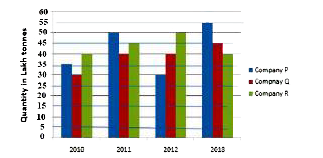The number of illiterate persons in a country decreased from 150 lakhs to 100 lakhs in 10 years. What is the percentage of decrease?
To find the percentage of decrease in the number of illiterate persons in a country, we can follow these steps:
Step 1: Identify the initial and final values
- Initial number of illiterate persons = 150 lakhs
- Final number of illiterate persons = 100 lakhs
Step 2: Calculate the decrease in the number of illiterate persons
- Decrease = Initial value - Final value
- Decrease = 150 lakhs - 100 lakhs = 50 lakhs
Step 3: Calculate the percentage of decrease
- The formula for percentage decrease is:
Percentage of Decrease=(DecreaseInitial Value)×100
- Substitute the values into the formula:
Percentage of Decrease=(50 lakhs150 lakhs)×100
Step 4: Simplify the fraction
- Simplifying the fraction:
50150=13
Step 5: Multiply by 100 to find the percentage
- Now, multiply by 100:
Percentage of Decrease=(13)×100=33.33%
Final Answer
- The percentage of decrease in the number of illiterate persons is 33.33%.
---
- Initial number of illiterate persons = 150 lakhs
- Final number of illiterate persons = 100 lakhs
- Decrease = Initial value - Final value
- Decrease = 150 lakhs - 100 lakhs = 50 lakhs
- The formula for percentage decrease is:
Percentage of Decrease=(DecreaseInitial Value)×100
Percentage of Decrease=(50 lakhs150 lakhs)×100
- Simplifying the fraction:
- Now, multiply by 100:
- The percentage of decrease in the number of illiterate persons is 33.33%.
Topper's Solved these Questions
Similar Questions
A number is decreased by 10% and the resulting number is again decreased by 20%. What is the final percentage of decrease?
View SolutionThe bar graph given below shows the data of the production of paper (in lakh tonnes) by three different companies P, Q and R over the years.

What is the percentage increase in the productionby company Q from 2010 to 2013?View Solution
Knowledge Check
- Question 1 - Select One
The population of a city increases at a rate proportional to the population at that time. If the polultion of the city increase from 20 lakhs to 40 lakhs in 30 years, then after another 15 years, the polulation is
A10√2lakhsB20√2lakhsC30√2D40sqrqt2lakhs - Question 2 - Select One
The radius of a cylinder is increased by 150 % and its height is decreased by 20 %. What is the percentage increase in its volume?
एक बेलन की त्रिज्या 150 % बढ़ा दी जाती है तथा इसकी ऊंचाई 20 % कम कर दी जाती है | इसके आयतन में कितने प्रतिशत की वृद्धि होगी ?A400%B600%C500%D80% - Question 3 - Select One
A number is decreased first by 30% and then it is again decreased by 30%. What is the percentage change in the number?
A60% decreaseB51% decreaseCNo changeD66% decrease
The rate at which the population of a city varies as the population at that time in period of 20 year population increased from 10 lakhs to 14 lakhs. Find the population in another 20 years.
View SolutionA number is increased first by 20% and then it is decreased by 10%. What is the percentage change in the number?
View SolutionA company's working capital is Rs 10 lakh (Negative balance) in the year 2018. It became Rs. 15 lakh (Positive balance ) in the year 2019 . What is the percentage of change ?
View SolutionIn an NGO the daily average wages of 20 illiterate employees is decreased from ₹25 to ₹10 thus the average salary of all the literate and illiterate employees is decreased by ₹10 per day . The number of educated employees working in NGO is :
View SolutionA number is increased first by 10% and then it is decreased by 10% .What is the percentage change in the number ? (a)11% increase (b)No change (c)1% decrease (d)11% decrease
View Solution

